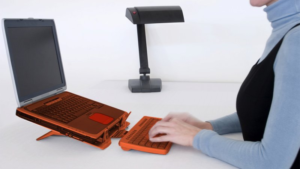Display screen equipment (DSE) is equipment or devices with an alphanumeric or graphic display screen – for example laptops, PCs, smartphones and tablets. Regular use of DSE can culminate in the development of a multitude of health problems. The most common issues are musculoskeletal problems, tired eyes, headaches and mental stress. However, it’s not all doom and gloom as these health risks can be mitigated through the introduction of good DSE use practices and proper workplace set-up. It is important that employers familiarise themselves with their responsibilities to their DSE users. The Health and Safety (Display Screen Equipment) Regulations 1992, which were subsequently updated in 2002, outline these responsibilities. The legislation covers risk assessment and modification of users’ workstations as well as the provision of health and safety training.
How Should a Display Screen Equipment Workstation be Set Up?
Setting up your chair appropriately is fundamental to ensuring good posture and reducing musculoskeletal pain. You should adjust the height so that your knees are in line with, or lower than, your hips with your feet planted flat on the ground. Some people require a footrest to properly support their feet. The back of your chair should support the entirety of your back whilst you sit up straight. Also, the arms of your chair should not prevent you from getting close to your desk; some people opt for a chair with no arms to overcome this limitation.
The positioning of your keyboard and mouse is also important as many DSE health problems involve the arms and shoulders. You must place your screen and keyboard directly in front of you, with your mouse situated to the side of your keyboard. Your forearms should be horizontal and your elbows hung at your sides as you type. Likewise, your wrists should remain straight and your fingers slightly curled. You must take care not to position your arms too low, hit the keys too hard or overstretch your fingers when typing. These are all common mistakes which can contribute towards the development of health problems.
Properly modifying your display screen to suit you individually helps to avoid headaches and tired eyes. Your monitor should be situated at an arm’s length away from you with your eyes in line with the top of the screen. The height must allow you to see the whole screen without turning or tilting your head. Additionally, the brightness and contrast settings of your monitor need to be modified to suit your environment and may need adjusting from day to day. Similarly, the angle of your monitor may need to be changed to reduce glare or the window blinds may require adjusting.
Organising your workspace in a logical manner also helps to protect you against the health risks of using DSE. Objects that you use regularly should be positioned closest to you whilst items used more rarely can be kept further away. Additionally, a paper holder should be fixed next to your monitor so that your paper documents are displayed next to your screen at the same height and distance away from you. This prevents awkward neck and eye movements when switching your gaze between the two.

How Does Workstation Set-up Affect Employees?
An employee’s workstation set-up can greatly impact the development of DSE-related health conditions. Musculoskeletal problems are commonly associated with bad posture which can quickly become a bad habit while using DSE. Properly setting up your chair and desk goes a long way towards combatting musculoskeletal pain, but a conscious effort to maintain good posture is also required. Both headaches and eye fatigue (tired eyes) can be caused by sitting too close to your display screen, screen glare and poorly setting up your brightness and contrast levels. Improper workstation set-up can also result in employee dissatisfaction and stress which impacts every aspect of their work life.
Employer Responsibilities
The Display Screen Equipment Regulation 1992 outlines an employer’s responsibilities regarding DSE users. An employer’s responsibilities extend to employees working at their employer’s workstation, another employer’s workstation or a home workstation. The workstation checklist is a useful tool for conducting DSE workstation risk assessments and can be completed by users themselves, if given the relevant training. The workstation checklist covers the following areas: keyboards, mouses, display screens, software, furniture (e.g. chair, desk and paper equipment) and working environment (e.g. space, lighting, air quality, temperature, noise).
To be classed as a DSE user under the legislation, workers must fulfil all the following criteria:
- Normally use DSE for continuous periods of an hour or more
- Generally use DSE daily
- Be required to transfer information quickly to or from the DSE.
Additionally, they must fulfil one of the following criteria:
- Have to use very high levels of attention and concentration
- Be highly dependent on the DSE, or have little choice about using it
- Require specialist training or skills in order to operate the DSE.
Why is Workstation Set-up Important for Employers?
Workstation set-up is crucially important as it helps protect the health of your employees. Employers must bear in mind that it is their legal responsibility to ensure that workstations are properly set up for their DSE users, under the Display Screen Equipment Regulations 1992 and 2002. As well as simply ensuring compliance with the law, proper workstation set-up can directly benefit your organisation. For example, inadequate workstation set-up could result in an employee developing shoulder pain which would in turn cause them suffering, inevitably affecting the quality of work they produce and maybe resulting in more sick days being taken. It makes simple business sense to ensure your employee’s health to the best of your ability. Additionally, the provision of mandatory display screen equipment training encourages employees to take responsibility for their own health and safety as well as fulfilling another requirement of the DSE regulations.


